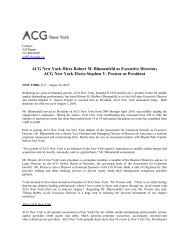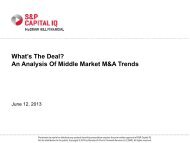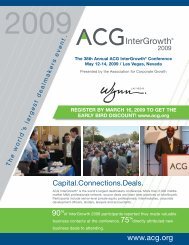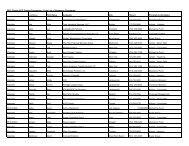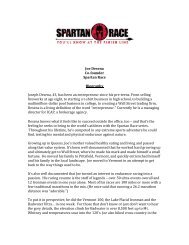September 2010 - Association for Corporate Growth
September 2010 - Association for Corporate Growth
September 2010 - Association for Corporate Growth
Create successful ePaper yourself
Turn your PDF publications into a flip-book with our unique Google optimized e-Paper software.
LBO Watch<br />
<br />
<br />
<br />
<br />
<br />
“ <br />
<br />
<br />
<br />
<br />
<br />
<br />
<br />
<br />
”<br />
For the past few years, leveraged buyouts have<br />
been notable <strong>for</strong> their lack of leverage. LBOs<br />
were routinely completed with a capital structure<br />
split roughly between equity and debt. The<br />
M&A markets continue to slowly improve, driven no<br />
doubt by a healthier lender universe. To some observers,<br />
however, the credit markets are outpacing M&A<br />
demand. In some cases, it can make it easy <strong>for</strong> PE<br />
buyers to pick up old habits.<br />
“Deal flow continues to disappoint so all the lenders<br />
are looking at everything,” describes Brian Crabb,<br />
a co-managing director of sponsor coverage in Fifth<br />
Third Bank’s leveraged finance group. “When good<br />
deals come along, the lenders start fighting over it.”<br />
The result is that certain properties can carry leverage<br />
more in line with what observers saw in the years<br />
leading up to the bubble.<br />
In April, <strong>for</strong> example, WL Ross & Co. and The<br />
Greenbrier Cos. were able to complete a deal to lease<br />
nearly 4,000 railcars in a transaction valued at about<br />
$230 million. The investment was roughly 90% levered.<br />
On average, though, it would be a hard case to<br />
make that leverage today resembles anything close to<br />
the bubble era. According to multiple sources, most<br />
middle-market deals are getting done with between<br />
2.75x and 3x senior with a turn or a turn and a half of<br />
mezzanine. For companies with north of $10 million<br />
of Ebitda, the multiples may move up a quarter to a<br />
half a turn. Standard & Poor’s Leverage Commentary<br />
and Data reported that average debt multiples were<br />
hovering at about 3.8x in the first quarter of <strong>2010</strong>,<br />
down from its recent peak of 4.9x in 2007.<br />
While a number of players have pulled out of the<br />
middle market lending arena, those that are active<br />
are familiar faces. Madison Capital Funding, Fifth<br />
Third, Golub Capital and GE Antares, “along with<br />
some regional banks,” look at most deals out there,<br />
according to one private equity investor, speaking<br />
anonymously.<br />
But the frothiness of the market moves in fits and<br />
starts. Madison Capital Funding’s Christopher Williams,<br />
a senior managing director at the firm, suggests<br />
that the market remains sensitive to macroeconomic<br />
concerns.<br />
“Leverage levels were getting aggressive until the<br />
European issues started creating uncertainty,” he says.<br />
Williams adds while things aren’t as frothy as they<br />
were earlier in the year and concern over Europe may<br />
linger, “the middle market is still doing alright.”<br />
As it relates to equity contributions, around 40%<br />
to 45% of the purchase price seems to be normal <strong>for</strong><br />
middle market acquirers. In the larger market, where<br />
more liquidity exists, around 30% equity could be<br />
considered a typical contribution. To call those figures<br />
the new normal, however, would imply that sponsors<br />
won’t attempt to contribute less when they can.<br />
One investor on the debt side told sister publication<br />
Leveraged Finance News (LFN), that while lenders<br />
may expect minimum equity contributions, their<br />
expectations soften as competition ramps up.<br />
“Minimum sponsor equity contributions are driven<br />
largely by market supply and demand; when too<br />
many lenders are chasing too few deals, the percent<br />
requirements go down,” the New York-based investor<br />
told LFN. “The bias is in that direction today, but not<br />
dramatically so.”<br />
Of course sellers may have expectations too. This<br />
might be the reason all-equity deals continue to pop<br />
up. In May, healthcare products provider Covidien<br />
sold its Specialty Chemicals business to New Mountain<br />
Capital <strong>for</strong> $280 million. New Mountain funded<br />
18 MERGERS & ACQUISITIONS <strong>September</strong> <strong>2010</strong>



